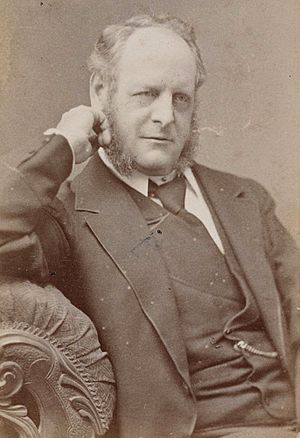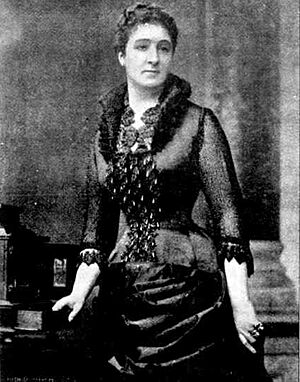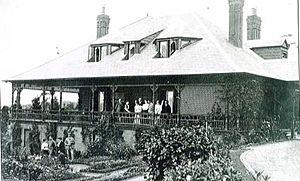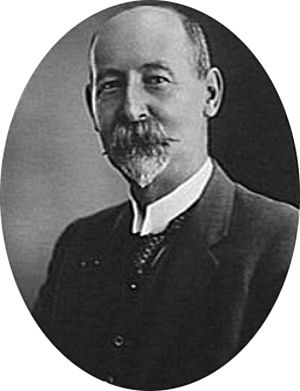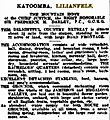Lilianfels, Katoomba facts for kids
Quick facts for kids Lilianfels |
|
|---|---|
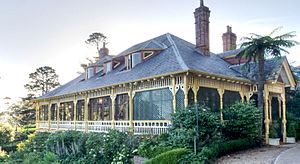 |
|
| Location | 10-16 Panorama Drive, Katoomba, City of Blue Mountains, New South Wales, Australia |
| Area | 6.1 hectares (15 acres) |
| Built | 1889 |
| Built for | Sir Frederick Darley and Lady Darley |
| Architect | Varney Parkes |
| Architectural style(s) | Queen Anne |
| Owner | Lilianfels Blue Mountains Pty Ltd |
| Official name: Lilianfels | |
| Type | State heritage (complex / group) |
| Designated | 2 April 1999 |
| Reference no. | 431 |
| Type | Other - Residential Buildings (private) |
| Category | Residential buildings (private) |
| Lua error in Module:Location_map at line 420: attempt to index field 'wikibase' (a nil value). | |
Lilianfels is a special old house in Katoomba, Australia. It was once a grand home and holiday spot, but now it's a fancy hotel. The house was designed by Varney Parkes and built in 1889. It was built for Sir Frederick Darley, who was a very important judge in New South Wales. He used it as his mountain getaway.
Sir Frederick named the house Lilianfels to remember his daughter, Lilian, who had recently passed away. "Lilian" was her name, and "fels" is a German word meaning "high ground." The Darley family owned the house for 20 years. Today, Lilianfels is part of a resort and spa. It offers places to stay, restaurants, and hosts special events like weddings. The property is listed on the New South Wales State Heritage Register, which means it's an important historical site.
Contents
The Story of Lilianfels
Sir Frederick Darley, a top judge in New South Wales, had this beautiful house built in 1889. He named it after his daughter, Lilian, who sadly died when she was 22. The house was a summer home for the Darley family. Later, the family of Ebenezer Vickery, a famous businessman, owned Lilianfels. Today, a restaurant called 'Darley's' is located in the original homestead. In 1992, 85 guest rooms were added in a new hotel building next door.
Who Was Sir Frederick Darley?
Sir Frederick Matthew Darley was born in Ireland in 1830. He studied law and became a lawyer in 1853. In 1860, he married Lucy Forest Browne in England. Lucy was from Australia, and her brother was the famous writer Rolf Boldrewood. Her family was very wealthy and well-known in Sydney.
In 1862, Sir Frederick decided to move to Sydney with his family to work as a lawyer. He became a member of the New South Wales Parliament. He knew many important people, including Sir Edmund Barton, who later became Australia's first Prime Minister.
In 1886, Sir Frederick became the Chief Justice of New South Wales. This was a very important job. His wife, Lady Lucy Darley, believed that mountain air was good for health. She even started a group called the Fresh Air League. This might have helped them decide to buy land in Katoomba in 1888.
They built their summer house, Lilianfels, in 1889. It was designed by architect Varney Parkes. The family used it as a holiday home, and many important visitors to Australia, including royalty, stayed there. They often hosted parties at their beautiful home.
A writer visited Lilianfels in 1894 and described it as one of the most beautiful mountain homes in the world. The writer said the view from the verandah was amazing, like something from Norway. Lady Darley loved to paint the beautiful scenery. The family enjoyed their time there, riding horses and relaxing.
In 1907, the Darleys decided to move back to England. They sold their homes in Sydney and Katoomba. Lilianfels was sold in 1908 to George Begg Vickery.
Other Owners of Lilianfels
George Begg Vickery and his family used Lilianfels as a summer home for four years. Then, they sold it to Albert Alexander Kemp in 1912. Albert and his wife, Eliza Jane, lived in the house all the time. They often hosted events and fundraisers there. They also invited friends to enjoy the amazing views.
One writer described the view from Lilianfels: "The Jamison Valley lies in front. It's covered in trees, with small clearings, and a stream making music. The rocks and peaks are always changing. It's a scene that needs a poet or artist to truly show its beauty. And it's never the same twice."
The Kemps sold the property in 1920 to James Joynton Smith, a well-known businessman. In 1923, Samuel George Baker bought the house. For the next 30 years, he rented it out to different people as a guest house. It continued to be a guest house until 1992. That's when a new hotel complex was built next door. Today, the hotel has 81 guest rooms and 4 suites. It has a 19th-century style, with a reading room and a billiards room. Darley's restaurant is still in the original summer home.
What Lilianfels Looks Like
The Gardens and Grounds
The gardens at Lilianfels today are designed to look like the old 19th-century gardens. Old photos helped decide how to arrange them. Some original tiles found on the property were used, and new ones were added. There are many types of trees and plants, including conifers, azaleas, and camellias. A cherry laurel hedge from an old photo (around 1915) is still there.
The gardens have grown a lot over time. You can still see parts of the old driveway, paths, and garden beds. There are also old brick drains, hedges, and steps. The driveway is lined with rhododendrons and laurels. Near the house, you'll find hydrangeas and agapanthus. The grounds have many different plants, thick groups of pine trees, and an area that was once a tennis court.
The House Itself
The main house is a strong timber building with weatherboard walls. It has a red brick base and a hipped slate roof. There are brick chimneys and windows called dormers that let light into the attic bedrooms. The dormer windows facing the Jamison Valley are unique. The chimneys are tall and have special brick designs.
The corners of the outside walls have interesting quoin details. Wide verandahs (porches) go around the house. The main verandah at the front and sides has wooden posts with pretty carved decorations. One side verandah has a colorful leadlight window. The steps leading up to the verandah are made of single pieces of slate, with tiled risers. The main entrance is under a small, pointed roof porch that sticks out from the verandah.
Other Buildings
The kitchen building was once separate but is now connected to the main house by a covered walkway. Its roof looks similar to the main house. There's also a small, separate cottage called The Kennels. It's made of weatherboard like the main house, but it's simpler. There's also a simple wooden shed with a slanted roof.
Why Lilianfels Is Important
Lilianfels is important for its history and social connections. It was the summer home of Sir Frederick Darley, a very important judge and leader in New South Wales.
The house is also beautiful and shows a great example of a late Victorian or early Queen Anne style house. It was designed by Varney Parkes and still looks much like it did originally. Some of the old inside decorations are still there, showing what homes and life were like back then.
The house, kitchen, cottage, and large gardens all create a lovely setting. They show what a summer home in the Blue Mountains was like. The gardens, even though they have changed, still have parts of the original design from the 1880s. They show how wealthy people from Sydney built grand summer homes in the Blue Mountains. The old trees, hedges, and views of the house help us understand the history of Echo Point.
The location of the house near Echo Point, with views over the Jamison Valley and its beautiful gardens, makes it very appealing. Lilianfels has been an important part of Katoomba's history and community. It's valued for its past and for its later role as a popular guest house.
Lilianfels was officially added to the New South Wales State Heritage Register on April 2, 1999.
Images for kids


